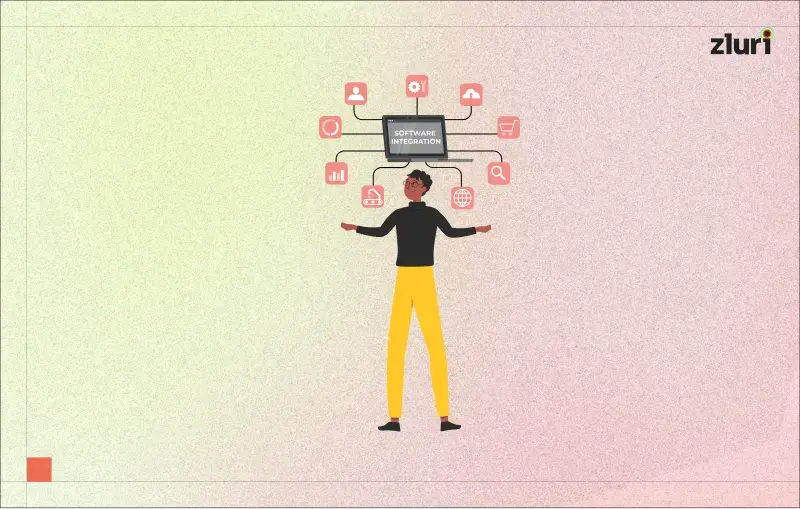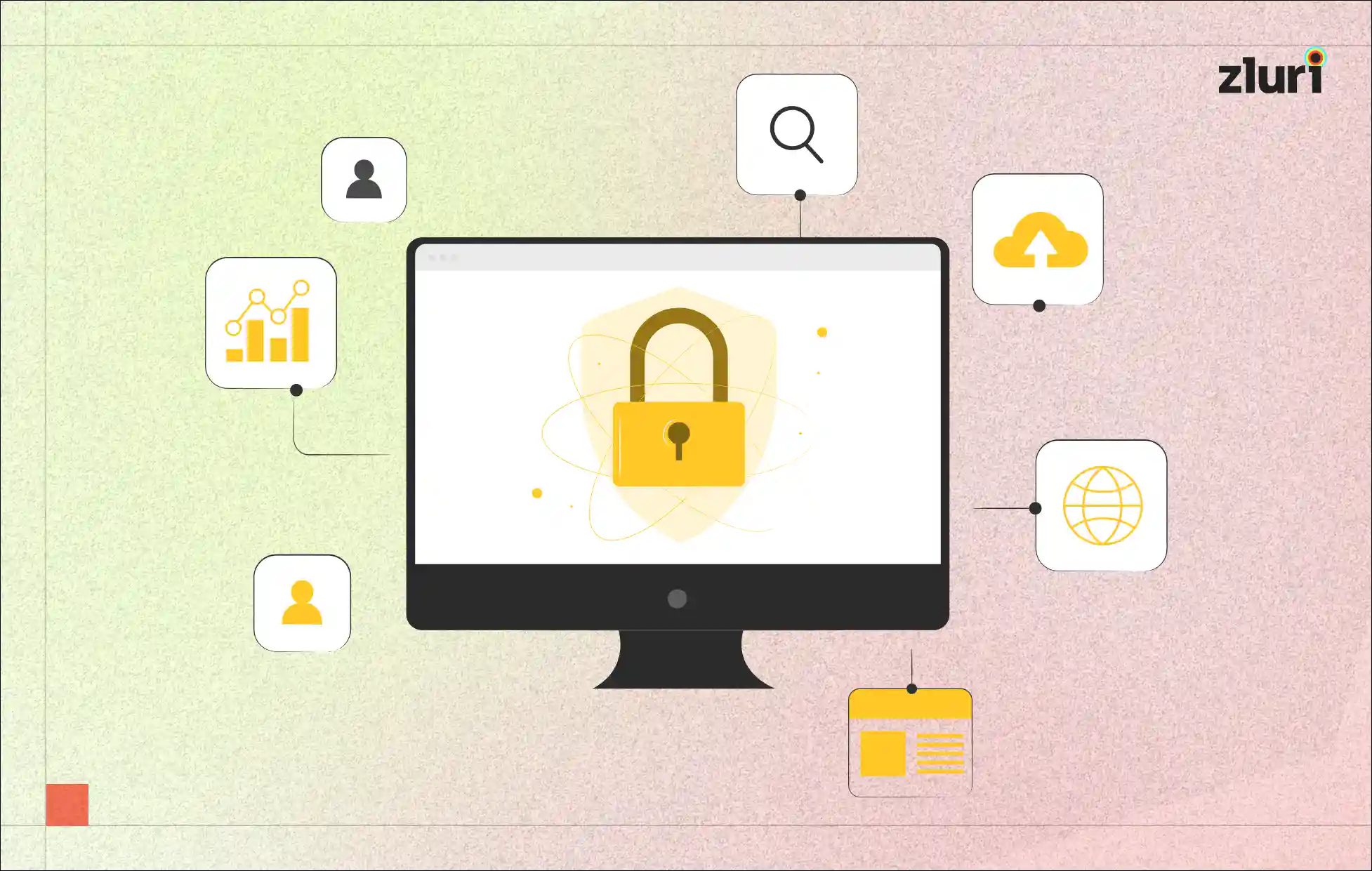The SSPM checklist includes security-centric strategies and policies across various SaaS vendors. It involves deploying SaaS security controls and monitoring critical apps to strengthen your organization's security posture. This, in turn, helps your team effectively secure their SaaS environment, ensuring complete protection against potential threats.
SSPM, or SaaS security posture management, is a dedicated security solution tailored to oversee and mitigate risks in SaaS applications. Unlike cloud security posture management (CSPM) systems, SSPM exclusively concentrates on securing SaaS applications.
It identifies threats like misconfigurations, inactive user accounts, excessive user privileges, and possible compliance violations. To capitalize on these advantages, having a comprehensive SSPM checklist is essential.
The SSPM checklist is a structured guide for implementing SaaS security posture management. It includes user authentication, data encryption, compliance monitoring, incident response planning, continuous monitoring, data loss prevention, vendor security assessment, identity and access management, security awareness training, and integration with SIEM solutions.
By adhering to these, organizations can systematically enhance security defenses and fortify SaaS applications against evolving cyber threats, establishing a strong security foundation.
In light of this, let's delve into the components of the SaaS security posture management checklist and why they are necessary.
Why Is There A Need For An SSPM Checklist?
According to the Cloud Security Alliance, 43% of enterprises faced security issues from SaaS misconfigurations, leading to up to 63% potential incidents. That's why having a well-organized SaaS security posture management checklist is imperative. It identifies and mitigates security threats, assuring the robust protection of corporate assets and maintaining data integrity.
In short, the SSPM checklist provides a proactive strategy by thoroughly analyzing SaaS setups and implementing automated monitoring and remediation methods.
Here are some compelling reasons why using a SaaS security posture management checklist is crucial:-
- Prioritizing Data Security: Safeguarding sensitive data stored in cloud-based applications stands as a paramount concern. An SSPM checklist ensures the effective implementation of data security measures, guarding against potential breaches and unauthorized access.
- Ensuring Regulatory Compliance: Adhering to industry-specific regulations and compliance standards is non-negotiable. An SSPM checklist aids in verifying that security measures align with regulatory requirements, mitigating the risk of legal repercussions and penalties.
- Continuous Vigilance: The ever-evolving landscape of cyber threats mandates continuous monitoring of SaaS applications. A checklist offers a structured approach to routinely assess security controls, proactively identifying and mitigating vulnerabilities.
- Critical User Access Management: Effectively managing user access to SaaS applications prevents unauthorized entry and ensures data confidentiality. An SSPM checklist verifies the efficacy of user access controls and permissions.
- Robust Incident Response Planning: A well-defined response plan is indispensable in the event of a security incident. An SSPM checklist aids in evaluating the organization's preparedness to respond to and recover from security breaches effectively.
- Vendor Risk Mitigation: Many organizations depend on third-party SaaS providers. An SSPM checklist aids in assessing and managing the security risks associated with these vendors, ensuring compliance with required security standards.Implementing an SSPM checklist proves instrumental in effectively addressing these challenges, offering a structured approach to elevate the overall security posture of an organization's SaaS environment.
SaaS Security Posture Management Checklist: 7 Key Elements
Addressing each organization's specific security needs and challenges is crucial when creating a robust SSPM checklist. A successful strategy prioritizes quick alerts, agile remediation, and continuous monitoring to fortify defenses against vulnerabilities and ensure timely identification and neutralization of potential cyber threats.
Let's explore essential components of the SaaS security posture management checklist:-
1: Identify & Catalog All SaaS Assets
The foundational element of the SSPM Checklist is SaaS asset inventory and management. This involves a comprehensive process of identifying and cataloging all network assets within an organization's SaaS environment.
- The initial step involves identifying every SaaS application and resource in use. Subsequently, these assets undergo systematic categorization and prioritization based on their criticality and relevance to organizational operations.It enables them to discern various applications and resources, facilitating a structured approach to effectively managing and securing these assets.
- Categorization allows for grouping assets based on similarities, aiding in creating targeted security protocols. Prioritization ensures that security efforts are focused on the most critical assets first, addressing potential vulnerabilities in a strategic and efficient manner. Overall, SaaS asset inventory and management is the cornerstone of a proactive and well-structured SaaS security management approach.
2: Conduct A Vulnerability Assessment For Your SaaS Stack
The second crucial element in the SSPM Checklist is vulnerability assessment for the SaaS environment. This involves the systematic and routine scanning of the entire SaaS landscape to identify potential weaknesses, security gaps, and vulnerabilities.
Through regular assessments, organizations can proactively detect and analyze security flaws that may expose the SaaS environment to potential threats.
- The first component of this element is the establishment of a consistent schedule for scanning the SaaS infrastructure. Regular scans ensure that any emerging vulnerabilities are promptly identified, providing a proactive stance against potential security breaches.
- Once vulnerabilities are detected, the second component comes into play – prompt remediation. This involves swift and effective measures to address and mitigate identified vulnerabilities, preventing them from being exploited by malicious actors.This contributes to a proactive security strategy by continuously evaluating the SaaS landscape for potential weaknesses and responding promptly to ensure a robust and secure environment. This element is integral to maintaining the integrity and resilience of the organization's SaaS infrastructure against evolving cybersecurity threats.
3: Implement Proactive Security Monitoring & Configurations For SaaS Stack
The third pivotal element within the SSPM Checklist is SaaS configuration management. This involves the vigilant monitoring and enforcement of security configurations across the organization's SaaS applications and resources. The primary objective is to ensure that the configurations align with established security policies and best practices.
- The first facet of this element encompasses continuous monitoring of security configurations in real-time. This involves the use of tools and processes to actively observe the settings and parameters of SaaS applications, verifying that they adhere to the predefined security standards. Through proactive monitoring, potential deviations or unauthorized changes can be swiftly identified, mitigating the risk of security breaches.
- The second aspect involves periodic reviews of configuration settings. Regular assessments are conducted to ensure that configurations remain up-to-date and aligned with evolving security requirements. These reviews serve as a proactive measure to address any changes in the SaaS environment or emerging security threats, guaranteeing that configurations are robust and resilient over time.This element plays a critical role in maintaining a secure SaaS environment by enforcing security configurations and conducting periodic reviews. It contributes significantly to the overall security posture of an organization's SaaS infrastructure.
4: Enforce Effective Access Control Throughout
Access control plays a crucial role in managing and securing user access within the SaaS environment through robust authentication and authorization processes.
- The first facet involves establishing stringent user authentication and authorization mechanisms. This ensures that only authorized users gain access to SaaS applications and resources. Authentication verifies the identity of users, while authorization determines the level of access privileges granted to them based on their roles and responsibilities.
- Another critical aspect of Access Control is the continuous monitoring of privileged access. Monitoring helps identify any anomalous or unauthorized activities associated with users who possess elevated access rights. This proactive measure enhances the organization's ability to detect and respond to potential security threats promptly.
- The final component is the periodic access review and adjustment of access permissions. Periodic assessments are conducted to validate that user access aligns with the principle of least privilege, minimizing the risk of unauthorized access. Adjustments are made as needed, reflecting changes in employee roles or organizational structure to ensure that access permissions remain accurate and secure.Access Control in the SSPM checklist strengthens SaaS security through robust user authentication, monitoring privileged access, and aligning permissions with organizational needs. This element contributes significantly to the overall resilience and integrity of the SaaS security posture.
5: Implement Real-Time Threat Detection & Response
The fifth critical element in the SSPM Checklist is "Threat Detection and Response." This element is designed to fortify the SaaS security posture by actively identifying and mitigating potential insider threats in real-time.
- The initial part involves the implementation of real-time threat detection mechanisms. This encompasses deploying advanced security tools and technologies that continuously monitor the SaaS environment for any signs of suspicious or malicious activities. The goal is to swiftly detect anomalies, unauthorized access attempts, or other indicators of compromise that may pose a threat to the security of the organization's SaaS assets.
- The second aspect is the establishment of automated response protocols for identified threats. Once a threat is detected, automated responses are triggered to neutralize or mitigate the impact of the threat. Automation ensures swift and consistent actions, reducing the response time and minimizing the potential damage caused by security incidents. These response protocols are carefully crafted to align with the organization's security policies and incident response plan.Threat detection and response is a proactive and dynamic element of the SSPM Checklist that enhances the organization's ability to swiftly identify and counteract potential threats to the SaaS environment.
6: Monitor Your Security & Compliance Landscape
"SaaS compliance monitoring" is one of the crucial elements in the SSPM Checklist. This element ensures that the organization's SaaS environment aligns with relevant industry standards and regulations, fostering a secure and compliant operational landscape.
- The first dimension involves the meticulous alignment of SaaS practices with industry standards and regulations. This includes staying abreast of evolving compliance requirements specific to the organization's industry. By adhering to these standards, organizations demonstrate a commitment to best practices, data protection, and regulatory obligations.
- The second facet encompasses regular audits to ensure ongoing compliance. Periodic assessments are conducted to validate that the SaaS environment continues to meet the specified compliance standards. These audits are proactive measures to identify and address deviations, ensuring that the organization complies with regulatory requirements.
- A critical component is documenting compliance status. This involves maintaining comprehensive records that detail the organization's adherence to industry standards and regulations. Well-documented evidence of compliance not only facilitates regulatory audits but also provides transparency and accountability in demonstrating the organization's commitment to security and data protection.This element contributes significantly to the overall governance and security of the organization's SaaS environment by aligning with industry regulations, conducting regular audits, and documenting compliance status.
7: Opt For An SMP For Enhanced SaaS Security
Managing a diverse range of SaaS applications can be overwhelming for IT admins. To avoid errors, you can consider using an efficient SaaS management platform like Zluri.
Zluri is designed to centralize and simplify the administration of all SaaS applications within your organization. It seamlessly integrates with 300+ SaaS tools, including identity platforms, directories, HRMS tools, and diverse applications, providing absolute command over your SaaS ecosystem.

Key Features:
- Effortless App Discovery: Zluri employs advanced discovery methods to ensure the comprehensive identification of SaaS applications. These methods include SSOs & IPDs, direct integrations, desktop agents, active directories, HRMS platforms, finance tools, MDM platforms, CASB platforms, and browser agents.

- Zluri’s nine discovery methodsAs per Kuppingercole's research and analysis report, these discovery methods help you get all the details of SaaS usage. Real-time tracking of SaaS usage enables your team to monitor application usage effectively, enhancing security by maintaining visibility into all software utilized within the organization.
- Enhanced Security and Compliance: Zluri provides robust security measures by encrypting sensitive data using secure algorithms and maintaining an auditable log of key activities and user access reviews. This ensures data protection and aids in meeting compliance requirements such as ISO 27001, SOC 2, GDPR, and more, thereby strengthening overall security posture and mitigating regulatory risks.
- Proactive Risk Assessment: Your team can evaluate threat levels, risk scores, and scopes to understand the potential risks associated with any SaaS apps. Zluri alerts users about critical apps with high threat levels, enabling proactive measures to maintain data confidentiality and prevent cyber threats, ultimately enhancing security resilience.
- Complete Control: Zluri empowers your team with complete control over the SaaS environment. By identifying security gaps, receiving compliance alerts, and making informed decisions, organizations can proactively address security vulnerabilities and maintain robust control over their SaaS applications, thereby minimizing risks and ensuring data integrity.Take charge of your SaaS security landscape with Zluri. Book a Demo today
Elevate SaaS Security with an SSPM Checklist
In conclusion, the SaaS security posture management checklist is a helpful source comprising essential elements that fortify an organization's defense against evolving cyber threats.
From meticulous asset inventory management to dynamic threat detection and compliance monitoring, each element is crucial in sculpting a resilient and adaptive security framework. By embracing the SSPM Checklist, organizations can safeguard sensitive data, ensure regulatory compliance, and foster a culture of continuous improvement in their SaaS security posture.
As the security landscape evolves, the SSPM Checklist is an invaluable tool, providing organizations with the means to address challenges and secure their SaaS environments effectively and proactively.
FAQs
1: Isn't SaaS security the responsibility of the cloud vendor?
The responsibility for SaaS security is a shared effort between the cloud vendor and the customer. Cloud service providers secure the application and its infrastructure components. Customers are accountable for safeguarding their data by efficiently managing all aspects of their SaaS security posture.
2: How often should SaaS security posture be assessed?
Regular assessments of the SaaS security posture are crucial to adapt to evolving threats. Organizations should conduct periodic evaluations, considering factors like emerging cyber threats, business operations changes, and SaaS application updates. This proactive approach ensures that security measures remain effective and aligned with the dynamic threat landscape.
3: What is Shadow IT, and why is it a potential danger?
Shadow IT refers to the unauthorized use of cloud applications by employees for job-related activities. These applications might lack proper configuration and the same level of security as approved solutions. Consequently, shadow IT creates security issues as malicious insiders can exploit these apps to exfiltrate valuable company data.
4: What steps can organizations take to mitigate the risks associated with Shadow IT?
Organizations can mitigate the risks of Shadow IT by implementing robust policies and controls. This includes conducting regular audits to identify unauthorized cloud applications and educating employees about approved solutions. This fosters a culture of transparency to encourage reporting of any unauthorized tool usage. Additionally, integrating Shadow IT discovery tools into the security framework can enhance visibility and control.
5: Can SaaS security measures be customized to fit specific organizational needs?
Yes, SaaS security measures can and should be customized to align with the unique needs and requirements of each organization. A one-size-fits-all approach may not be suitable. So, organizations need flexibility to customize security measures for their industry, compliance, and internal policies. This customization enhances the effectiveness of the SaaS security posture management strategy.









.svg)














